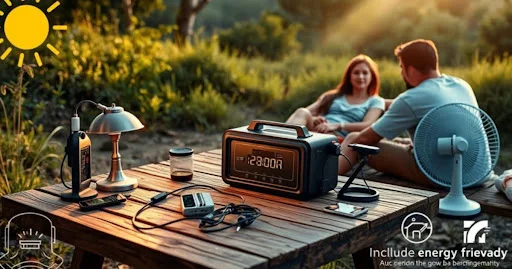Ever been stuck in the middle of nowhere with a dead phone, no signal, and zero power? Or maybe the lights went out at home during a storm, and you wished you had something, anything, to keep your devices running. Trust me, I’ve been there. That’s when I realized how badly I needed a Portable power Station in my life.
In this blog, I’ll walk you through everything you need to know about a portable power station, what it is, how it works, and why it’s one of the smartest tools you can own today. Whether you’re camping, prepping for emergencies, or just want backup power at home, this guide will help you make the right choice. Let’s dive in!
Explore related article to deepen your understanding before you go.
Understanding What a Portable Power Station Is
A portable power station is a compact, rechargeable device that stores electricity and lets you power or charge gadgets anytime, anywhere. It usually comes with multiple outlets like USB ports, AC sockets, and even car chargers. Think of it as a mini power bank, but way more powerful and useful.
People use it when camping, traveling, or during power outages at home. You don’t need gas like a generator, and it’s super quiet and easy to carry. It’s a safe, eco-friendly way to stay connected and powered up wherever you are.
How a Portable Power Station Works
A portable power station works by storing energy in a built-in battery that you can recharge using a wall outlet, car charger, or solar panel. Once charged, it lets you plug in and power various devices like phones, laptops, mini-fridges, or lights. It converts the stored energy into usable electricity through different output ports.
Inside, it has an inverter that changes the battery’s DC power into AC power, which most of your home devices use. Some models even come with displays showing battery level, input/output wattage, and run time. It’s like having a small, smart power source wherever you go.
Different Types of Portable Power Stations
- Lithium-Ion Power Stations: Lightweight, long-lasting, and perfect for daily use or travel. Most modern models use this battery type.
- LiFePO4 (Lithium Iron Phosphate): Safer and more durable, great for long-term or heavy use, though slightly heavier and pricier.
- Solar-Powered Stations: Can be charged using solar panels, ideal for off-grid adventures or eco-conscious users.
- Gas-Powered Generators (Portable Hybrid): Not fully electric, but some combine gas and battery for longer power backup. Louder and heavier.
- Mini Power Stations: Small, ultra-portable versions mainly used to charge phones, tablets, or small devices on the go.
Battery Capacity and Power Output Explained
Battery capacity tells you how much power a portable power station can store, usually measured in watt-hours (Wh). The higher the number, the longer it can run your devices. It’s like the size of a fuel tank, the bigger it is, the more energy you get.
Power output shows how much electricity it can deliver at once, measured in watts (W). This decides what kind of devices you can run, like phones, fans, or even a coffee maker. Always check both numbers to make sure it meets your needs.
Charging Methods: AC, DC, and Solar Input
Portable power stations can be charged in a few different ways, depending on what’s available. The most common method is AC charging, which means plugging it into a regular wall outlet at home. It’s fast and easy, perfect for everyday use or prepping before a trip.
Another option is DC charging from your car’s cigarette lighter port while you drive. For outdoor lovers, solar input lets you recharge using sunlight with compatible solar panels. It’s eco-friendly and great for off-grid adventures, though it can be slower depending on sunlight conditions.
Devices and Appliances You Can Power
A portable power station can power a wide range of devices, depending on its battery size and output. Small ones are perfect for charging phones, tablets, laptops, cameras, and Wi-Fi routers. They’re great for daily use, remote work, or travel.
Larger models can run appliances like mini-fridges, CPAP machines, fans, TVs, and even coffee makers. Some high-watt units can handle power tools or small kitchen gadgets too. Just check the wattage of your device and match it with the power station’s output.
Advantages of Using a Portable Power Station
Using a portable power station comes with some awesome benefits. It gives you instant backup power during outages, so you can keep your phone, lights, and internet running. Plus, it’s silent and clean, unlike gas generators that are noisy and smelly.
It’s also super easy to carry around for camping, travel, or road trips. Many models support solar charging, which means you can go off-grid and still stay powered. Best of all, there’s no fuel, no fumes, just safe, reliable energy wherever you need it.
Limitations and Things to Keep in Mind
While portable power stations are super handy, they do have a few limits. Most can’t run heavy-duty appliances like air conditioners or microwaves for long. Their battery capacity can drain quickly if you plug in high-wattage devices.
Charging can also take several hours, especially with solar panels in cloudy weather. They’re not a full replacement for home generators in long outages. So it’s important to choose one that fits your specific needs and know its limits before relying on it.
Safety Guidelines for Efficient Usage
To use a portable power station safely and efficiently, always read the user manual before your first charge. Avoid overloading it, check the power ratings of your devices and don’t plug in more than it can handle. Use it in a dry, cool place to prevent overheating or moisture damage.
Keep the vents clear so it doesn’t overheat while charging or powering devices. Never use it near flammable materials, and store it properly when not in use. Regularly check the battery level and recharge it every few months, even if you’re not using it.
FAQ’s
What is a Portable Power Station?
A Portable Power Station is a compact battery-powered device that stores energy and powers electronics like phones, laptops, or small appliances anywhere, anytime.
How does a Portable Power Station work?
A Portable Power Station charges through a wall socket, car, or solar panel and converts stored energy to power devices through USB, AC, or DC ports.
What can a Portable Power Station power?
A Portable Power Station can power phones, laptops, fans, CPAP machines, lights, mini-fridges, and other small to medium electronic gadgets during travel or emergencies.
How long does a Portable Power Station last?
Battery life of a Portable Power Station depends on capacity and device usage but usually lasts from a few hours to several days on a single charge.
Can I use a Portable Power Station indoors?
Yes, a Portable Power Station is safe to use indoors since it produces no fumes or noise, making it perfect for home use during power outages.
Conclusion
A Portable Power Station is one of the smartest tools you can own for backup power, outdoor fun, or travel needs. It’s safe, quiet, and easy to use, making it perfect for charging phones, laptops, lights, and even small appliances during emergencies or off-grid adventures.
Whether you’re camping, working remotely, or facing a sudden power outage, a Portable Power Station gives you peace of mind and reliable energy. Just choose the right size, follow safety tips, and stay powered wherever life takes you.
Want to learn more? Our other posts are just a click away!






